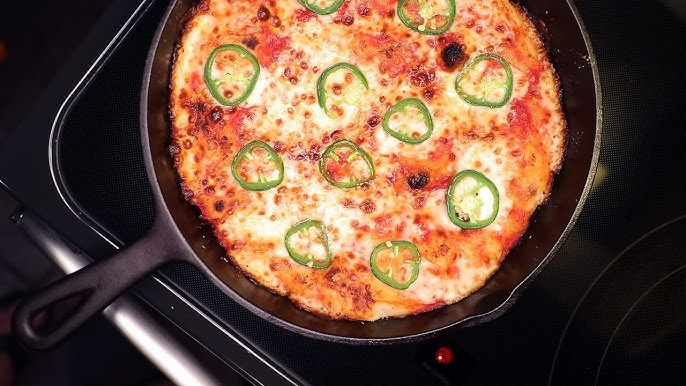Cast Iron Pizza Recipe: If you’ve never made pizza in a cast iron skillet, you’re in for a real treat. This method gives you that golden, crispy crust you love in restaurant pies—without the fancy pizza oven. Whether you’re a total kitchen newbie or a home-cooking pro, this step-by-step guide will walk you through every detail of how to make the perfect cast iron pizza from scratch.
Let’s ditch the delivery tonight. You’re about to learn how to make a pizza so good, it might just ruin takeout for you forever.
Ingredients You’ll Need
Before we start, let’s break down everything you need. Here’s your full grocery list—don’t skip anything if you want that wow-factor bite.
Dough Ingredients
Making your own dough? Good call. It’s easier than you think.
- 2 ¼ tsp active dry yeast (1 packet)
- 1 ½ cups warm water (about 110°F)
- 3 ½ cups all-purpose flour
- 2 tbsp olive oil
- 1 tsp sugar
- 1 ½ tsp salt
Sauce Ingredients
Skip the jar—this quick sauce is bursting with flavor.
- 1 can (14 oz) crushed tomatoes
- 2 garlic cloves, minced
- 1 tbsp olive oil
- 1 tsp dried oregano
- 1 tsp dried basil
- Salt to taste
- Pinch of sugar (optional, for acidity balance)
Cheese and Toppings
Now it gets fun. Mix and match your toppings or go classic.
- 2 cups shredded low-moisture mozzarella
- ¼ cup grated parmesan
- Pepperoni slices
- Bell peppers, mushrooms, onions
- Fresh basil (optional)
- Red pepper flakes (optional)
Optional Garnishes
- Olive oil drizzle
- Crushed red pepper
- Fresh arugula
- Garlic butter crust
Benefits of Cooking Pizza in a Cast Iron Skillet
Why go the cast iron route? Glad you asked.
Cast iron skillets are pizza-making MVPs. Why? They retain and evenly distribute heat like a champ. That means the entire crust gets golden and crisp—not just the edges.
You don’t need a pizza stone or steel. The skillet gives you that same heat blast that mimics a brick oven, especially when you preheat it right. Plus, it creates a shallow pan-style pizza that’s hearty and filling.
And let’s be honest—there’s just something satisfying about cooking in cast iron. It feels rustic, legit, and borderline gourmet. Trust us, once you go cast iron, you’ll never look back.
Choosing the Right Cast Iron Skillet
Not all skillets are created equal. Here’s what to look for:
Size Matters
For a standard pizza, a 10- or 12-inch cast iron skillet works great. Larger skillets = thinner crust. Smaller = thicker, more pan-style.
Pre-Seasoned vs. Unseasoned
Most skillets these days come pre-seasoned (yay), but if you’ve got a brand-new one, be sure to season it before use. That means heating oil into the surface so it becomes nonstick.
Deep Dish or Flat?
Flat skillets give you a thinner, crispier crust. Deep dish skillets are for thicker, Chicago-style pies. Pick your style and stick with it.
Preparing the Pizza Dough from Scratch
This is where the magic begins.
Activate the Yeast
In a bowl, mix warm water and sugar. Sprinkle in the yeast and let it sit for 5-10 minutes. If it gets bubbly and foamy, you’re good. If not, your yeast is dead—start over.
Mix & Knead
Add flour, salt, and olive oil. Mix until shaggy, then knead on a floured surface for 8-10 minutes. You want a smooth, elastic dough.
First Rise
Place dough in a greased bowl, cover it, and let it rise for 1-1.5 hours in a warm place until doubled in size.
Punch & Proof
Punch it down, form into a ball, and let it rest again for 20 minutes. This helps with shaping later.
You can also refrigerate overnight for more flavor, just bring it to room temp before using.
Making the Homemade Pizza Sauce
Let’s be real—the sauce makes the pizza. A bland or watery sauce can ruin everything. But don’t worry, making a killer pizza sauce at home is easier (and tastier) than grabbing that jar off the store shelf.
Quick Stovetop Method
Start by heating olive oil in a small saucepan over medium heat. Toss in your minced garlic and let it sizzle for about 30 seconds—don’t let it brown, or it turns bitter.
Pour in your crushed tomatoes, then stir in the oregano, basil, salt, and a pinch of sugar. Let it simmer for 15–20 minutes, stirring occasionally. The sauce will thicken and develop those rich, herby notes that scream homemade goodness.
Taste it. Add more salt or a bit of sugar if the tomatoes are too acidic. Want heat? A sprinkle of red pepper flakes adds a nice kick.
Pro Tips:
- Add a splash of balsamic vinegar or a touch of tomato paste for extra depth.
- If you want a smoother sauce, give it a quick blend.
- Store leftovers in a jar in the fridge—it keeps for up to a week, or freeze it for next time.
Prepping the Skillet for the Pizza
This step is mission critical. You don’t want your pizza sticking to the pan or ending up soggy.
How to Preheat the Skillet
Place your cast iron skillet on the stove over medium heat for 5–7 minutes. This preheats the pan and helps ensure a crispy bottom. If you skip this step, the crust might bake unevenly.
Alternatively, you can pop the skillet into a 450°F oven for 10 minutes while prepping the dough and toppings.
Greasing the Skillet
Once hot, carefully remove the pan and add a generous layer of olive oil—around 2 tablespoons. Swirl it around so the bottom and sides are coated. This not only prevents sticking but also crisps up the outer edges like a dream.
Some pizza pros even use butter or a mix of oil and cornmeal to add texture to the base. Experiment and see what you love best.
Temperature Control
Don’t go too high on the stovetop—medium is perfect. You want the crust to firm up, not burn before the rest is even cooked.
Shaping the Dough for the Skillet
This part can be tricky, especially if you’re new to working with dough. But don’t worry—it’s not about perfection. It’s about stretch and fit.
How to Stretch Without Tearing
Take your dough ball and place it on a lightly floured surface. Using your fingertips, gently press it into a circle, working from the center out. Avoid using a rolling pin—it flattens the air bubbles that make your crust chewy and light.
Lift the dough and use the backs of your hands to stretch it further, letting gravity do some of the work. Be gentle. If it tears, just pinch it back together.
Fitting Dough in the Skillet
Once your dough is roughly the size of your skillet, carefully place it into the preheated, oiled pan. Press it into the edges so it fits snugly, even climbing a little up the sides if you like a more defined crust.
If the dough resists stretching or springs back, let it rest for 5–10 minutes and try again.
Docking the Dough (Optional)
Docking means poking the dough with a fork a few times. This helps prevent giant bubbles while cooking. Totally optional, but handy if your dough tends to puff unpredictably.
Building the Pizza: Sauce, Cheese & Toppings
Alright, now comes the best part—making it yours.
What Goes First? Sauce or Cheese?
Traditionally, it’s sauce first, then cheese, then toppings. But hey, this is your pizza—some people go cheese first to prevent a soggy crust. Either way, don’t overload it.
Spread a thin layer of sauce over the dough using the back of a spoon. Leave about ½ inch border for the crust.
Sprinkle mozzarella evenly on top, followed by parmesan. Now add your toppings—go light, especially with watery veggies like mushrooms or peppers. Too much = soggy pizza.
Layering Tips
- For crispier veggies, sauté them slightly before adding.
- For more flavor, add herbs like oregano or crushed garlic on top.
- For better texture, layer pepperoni over cheese so they crisp up.
Cooking on the Stovetop (Optional Step)
Want that super crispy crust? Try this secret weapon—cook it on the stovetop before finishing in the oven.
Place the skillet (with the assembled pizza) back on the stove over medium heat. Let it cook uncovered for 3–4 minutes. This jumpstarts the crust and gives it a beautiful golden-brown bottom.
You’ll hear it sizzle. That’s the sound of awesome happening.
Once you see the edges start to firm up and the bottom feels crisp when lifted with a spatula, it’s time to move to the oven.
Baking in the Oven
Time to finish it off.
Preheat your oven to 450°F (232°C). Place your skillet on the middle rack and bake the pizza for 12 to 15 minutes.
Watch the crust—when it’s golden and the cheese is bubbling and starting to brown in spots, it’s done.
Want that extra touch? Turn on the broiler for the last 1–2 minutes to blister the cheese and brown the toppings a bit more.
But keep an eye on it! Cast iron holds heat like a beast—it can go from perfection to burnt in seconds under a broiler.
Getting That Perfect Crust: Tips & Tricks
Let’s talk crust goals.
Want crispy, golden, and slightly chewy edges? Try these tips:
- Oil the edges before baking. Use a brush or your fingers to lightly coat the crust. It fries a bit while baking and adds flavor.
- Don’t underbake. A doughy center ruins the bite.
- Use a thermometer to check the bottom—190–200°F means it’s done.
Also, avoid the temptation to cut right away. Let it rest for 5–10 minutes first. This keeps the cheese from sliding off and the crust from going soggy.
Serving the Pizza Right
You’ve pulled it from the oven, and the smell is mouthwatering. But don’t grab that pizza cutter just yet—timing matters when it comes to serving cast iron pizza.
Let It Rest First
As tempting as it is to dive in, let your pizza rest in the skillet for 5–10 minutes. This helps the cheese set and the sauce settle, so you’re not dealing with a messy, sliding slice. The crust also firms up just a bit more as it cools, giving you that perfect bite.
How to Cut It
Use a large spatula to carefully slide the pizza out of the skillet onto a cutting board. If it’s sticking, gently work a silicone or wooden spatula underneath. Never use metal—it can scratch your seasoning.
Use a sharp pizza cutter or large chef’s knife to slice it up. Go with classic wedges or get fancy with squares if you made a deep-dish style.
Garnishing Tips
Want to level up your cast iron pizza? Garnish like a pro.
- Fresh basil leaves add a pop of color and flavor
- A drizzle of olive oil or balsamic glaze enhances richness
- Sprinkle with red pepper flakes or parmesan for extra zing
- Add a handful of fresh arugula for a peppery, fresh contrast
Serve it hot, melty, and proud. Pair with a simple salad or a cold drink, and boom—you’ve got a better-than-delivery meal on your hands.
Cleaning the Cast Iron Skillet After Pizza
Now that the eating is done, let’s talk cleanup. You don’t want to ruin your skillet—or your hard-earned seasoning—with the wrong cleaning method.
Skip the Soap
First rule of cast iron club: no soap. It strips the natural seasoning that keeps your pan non-stick and rust-free.
Instead, let the skillet cool a bit, then wipe out excess oil and crumbs with a paper towel. If anything’s stuck, pour in some hot water and use a non-abrasive scrubber or a chainmail cast iron scrubber to gently clean it.
Stuck-On Bits?
Got stubborn crusty cheese or burnt bits? Heat a little water in the skillet until it simmers, then scrape gently with a wooden spoon. That usually loosens everything up.
Dry and Re-Season
Once clean, dry the skillet completely with a towel, or put it over low heat on the stove for a minute to evaporate any water.
Then rub a light coat of oil (vegetable, canola, or flaxseed oil) over the surface. Wipe off excess and store in a dry place. This keeps it rust-free and ready for your next pizza night.
Common Mistakes to Avoid
Even experienced cooks mess up a cast iron pizza now and then. Avoid these classic mistakes to make sure yours turns out perfect every time.
1. Using Too Much Sauce
More sauce ≠ more flavor. Too much liquid makes the crust soggy, and nobody wants a floppy pizza. Stick to a thin, even layer.
2. Skipping the Preheat
Always preheat your skillet. A cold pan means uneven cooking and a soft bottom crust. A hot pan gets that restaurant-style crispy base.
3. Overloading Toppings
Too many toppings make the pizza heavy and messy. Keep it balanced so the dough can cook properly underneath. Less is more.
4. Not Letting Dough Rest
Trying to stretch cold dough is a nightmare. Let your dough rest at room temp before shaping—it’ll be way easier to work with.
5. Cutting the Pizza Too Soon
Rest that pizza. Trust us. Give it 5–10 minutes so the cheese doesn’t ooze off and the crust finishes crisping.
Avoid these pitfalls, and your pizza will go from good to legendary.
Cast Iron Pizza Variations
Feeling adventurous? You don’t have to stick to pepperoni and cheese. Here are a few delicious cast iron pizza ideas to try next time:
Margherita Pizza
- Fresh mozzarella
- Homemade tomato sauce
- Fresh basil leaves
- Olive oil drizzle
Simple. Classic. Perfect for summer nights.
Meat Lover’s Pizza
- Pepperoni, sausage, bacon, and ham
- Mozzarella and cheddar blend
- Spicy tomato sauce
This one’s a full meal in every bite. Heavy but oh-so-satisfying.
Veggie Supreme
- Bell peppers, red onions, olives, mushrooms, spinach
- Light tomato sauce
- Mozzarella and feta mix
Great for a meatless Monday or a lighter lunch option.
White Pizza
- No tomato sauce—use garlic butter or ricotta base
- Mozzarella, ricotta, parmesan
- Spinach or arugula
Rich, creamy, and full of garlicky flavor. Perfect when you want to switch it up.
The possibilities are endless—experiment and find your signature pie.
FAQs about Cast Iron Pizza Recipe
1. Can I use store-bought dough instead of making it from scratch?
Absolutely! Store-bought dough works just fine if you’re short on time. Just let it come to room temp before shaping, and follow the rest of the steps as usual.
2. What if I don’t have a cast iron skillet?
You can try using an oven-safe stainless steel pan or a heavy-duty nonstick skillet, but the crust might not crisp up the same. Cast iron is worth the investment.
3. How do I store leftover pizza?
Store slices in an airtight container in the fridge for up to 3–4 days. Reheat in a skillet over medium-low heat or in the oven for best results. Avoid the microwave—it makes the crust soggy.
4. Can I cook cast iron pizza on the grill?
Yes! Place your cast iron skillet directly on the grill grates over medium heat. Close the lid to mimic an oven and follow the same cooking times. Grilled pizza is smoky and amazing.
5. What cheese melts best for cast iron pizza?
Low-moisture mozzarella is your best bet—it melts beautifully and doesn’t release too much water. Combine it with parmesan, provolone, or even cheddar for extra flavor.
Conclusion
Making cast iron pizza at home is so much more than a recipe—it’s an experience. It’s about taking control of your cravings, filling your kitchen with the smell of garlic and bubbling cheese, and creating something you’re proud to serve.
With the right ingredients, a solid skillet, and a little love, you can skip the takeout and make a pizza that beats most restaurants—no lie. Once you’ve nailed it once, you’ll come back to this method again and again.
So go ahead. Heat that skillet. Knead that dough. Pile on those toppings. Your perfect slice is just a few steps away.



